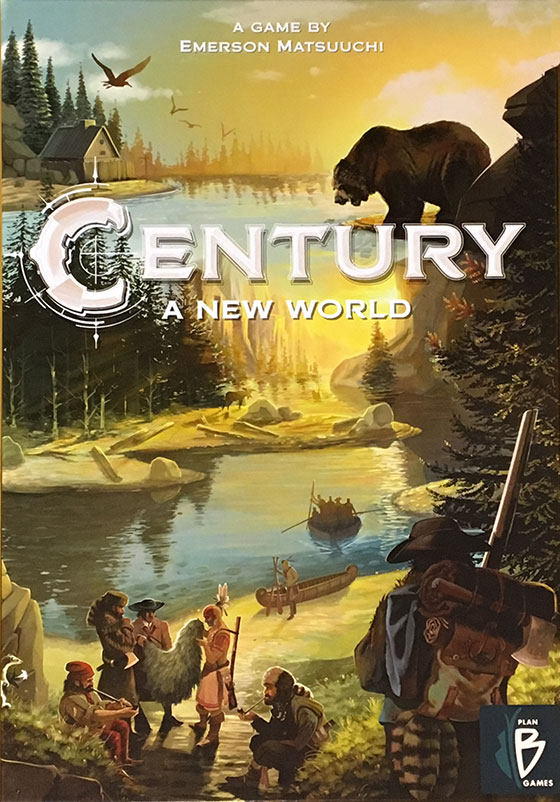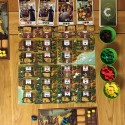‘Century: A New World’ Board Game Review

After three years, Emerson Matsuuchi’s Century trilogy is finally complete. The latest and final edition, Century: A New World is now available and players of the previous games (Century: Spice Road and Century: Eastern Wonders) will be keen to see how the new game plays on its own, as well as when integrated with the other two games either one to one, or with all three games in the mix. For those who might not have followed this series of games, it’s unique because Matsuuchi’s design allows each Century game to integrate with the others to create different – albeit similar – experiences.
This review will focus on Century: A New World in its basic form, since we haven’t yet had chance to try all of the different combinations when integrated with Spice Road and Eastern Wonders. I will mention the components and the fact that there are some pieces which are only used in one game or another, but as with Eastern Wonders, the number of pieces that are exclusively used in one or more of the integrated modes is quite few.
Fundamentally, Century: A New World is a relatively straightforward worker placement and set collection game, wherein the players use their expanding number of worker meeples to generate and upgrade resources before trading them in to fulfil contracts. In this way, A New World plays feels quite similar to Spice Road, except that here the need to use workers to drive the action (and the occasional need to recall them) introduces additional complexity. There are also bonus tiles that can be claimed in order to enhance final score, as well as exploration tokens that can be taken for bonuses and to open up new spaces on the board.
On a turn, the active has player has only two options available to them – either to place workers, or to withdraw them. When workers are placed, the player must use the number of meeples shown on the space they wish to use (usually between one and three) depending on the power of the action. One meeple can draw two corn, for example, but it takes three meeples to claim one fur. Some spaces allow specific combinations of resources to be upgraded (just as in Spice Road) whilst others allow trades of specific resources for a better outcome. When the withdraw action is used, the player forfeits their turn, but withdraws all their meeples for use again.
So far, this is just Spice Road but with worker placement. What differentiates Century: A New World, whilst also making it a lot more complex, is the engine building element attached to the worker placement actions. As players claim contracts (achieved by trading goods when using the fort action spaces at the top of the board) then they will expand their capabilities and network in The New World. The Native Help cards, for example, show symbols that match spaces on the board, and whenever the player uses those spaces, they will place one fewer meeples. Other symbols will allow the player to draw extra resource when using a certain space.
In many ways, I prefer the additional complexity that a New World brings, especially because the game remains relatively accessible and simple to explain. Century hasn’t become a heavyweight eurogame since it was first conceived, it’s just matured and changed a bit to allow a casual audience to experience some of the more complex rules that eurogames tend to include. The downside is that some of the engine building features are hard to track and we often found ourselves missing out on the in game bonuses in our first four or five games.
One very interesting new feature is that of exploration. At the beginning of the game, about half the spaces will be available for players to use, with the other half or so covered by exploration tokens. When some contracts are complete, they allow the player who claims them to remove an exploration token, which adds the explored space to the board for future actions to be taken. Exploration tokens also usually come with a benefit of their own, such as being able to take resources, or adding more symbols that count towards the end game bonuses.
Exploration is important in Century: A New World because the board feels quite compact at the outset, and the feeling only gets worse as the players gain access to more settlers (which is also via completion of contracts.) To combat the need for players to access the same spaces early in the game, A New World features the concept of bumping, which is when a player returns another players meeples to their board in order to use an occupied space. When doing so, the incoming player will need to spend one additional meeple, making it a costly action for them that also replenishes their opponents reserve of worker meeples.
When you take into account the fact that it simply has more rules and more complex elements to work out and add those things to the generally meatier decisions, it’s clear that Century: A New World is a heavier game that either of the other Century games, yet it remains pretty fast and fluid. Spice Road, in my house, is the benchmark against which all light card games are measured and we continue to love it today, but we liked Eastern Wonders less because it didn’t seem to create much competition for spaces or contracts. Century: A New World achieves both – being quick and simple, as well as very competitive.
In summarising, if I were only to own one Century game, it would either be Century: A New World or Spice Road, but choosing between them is really tough. With that said, because these games are designed as a trilogy and there are three new games (A New World combined with either of the other two and then all three together) that I haven’t even tried yet, I feel no compulsion to limit myself to only one of them. As a trilogy, the Century games are fantastic and I really love Emerson Matsuuchi’s ambition in creating a series of games that link together in interesting ways. Certainly a must have for fans of the other games, and possibly the defining moment in the trilogy, if you’re wondering where to start.
**** 4/5
Century: A New World is available online at 365Games.co.uk, or at your local games store. Don’t know where yours is? Try this handy games store locator

















































